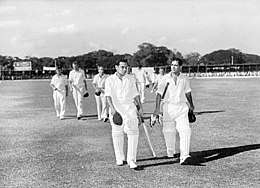Vinoo Mankad
 Mankad (right) and Pankaj Roy returning to the pavilion after their record partnership of 413, Madras, 1956 | ||||||||||||||||||||||||||||||||||||||||
| Personal information | ||||||||||||||||||||||||||||||||||||||||
|---|---|---|---|---|---|---|---|---|---|---|---|---|---|---|---|---|---|---|---|---|---|---|---|---|---|---|---|---|---|---|---|---|---|---|---|---|---|---|---|---|
| Full name | Mulvantrai Himmatlal Mankad | |||||||||||||||||||||||||||||||||||||||
| Born |
12 April 1917 Jamnagar, Bombay Presidency, British India | |||||||||||||||||||||||||||||||||||||||
| Died |
21 August 1978 (aged 61) Bombay, Maharashtra, India | |||||||||||||||||||||||||||||||||||||||
| Nickname | Vinoo | |||||||||||||||||||||||||||||||||||||||
| Batting | Right-handed | |||||||||||||||||||||||||||||||||||||||
| Bowling | Slow left arm orthodox | |||||||||||||||||||||||||||||||||||||||
| Relations |
Ashok Mankad (son) Atul Mankad (son) | |||||||||||||||||||||||||||||||||||||||
| International information | ||||||||||||||||||||||||||||||||||||||||
| National side | ||||||||||||||||||||||||||||||||||||||||
| Test debut (cap 30) | 22 June 1946 v England | |||||||||||||||||||||||||||||||||||||||
| Last Test | 11 February 1959 v West Indies | |||||||||||||||||||||||||||||||||||||||
| Domestic team information | ||||||||||||||||||||||||||||||||||||||||
| Years | Team | |||||||||||||||||||||||||||||||||||||||
| 1935–1936 | Western India | |||||||||||||||||||||||||||||||||||||||
| 1936–1942 | Nawanagar | |||||||||||||||||||||||||||||||||||||||
| 1936–1946 | Hindus | |||||||||||||||||||||||||||||||||||||||
| 1943–1944 | Maharashtra | |||||||||||||||||||||||||||||||||||||||
| 1944–1951 | Gujarat | |||||||||||||||||||||||||||||||||||||||
| 1948–1949 | Bengal | |||||||||||||||||||||||||||||||||||||||
| 1950–1951 | Saurashtra | |||||||||||||||||||||||||||||||||||||||
| 1951–1956 | Bombay | |||||||||||||||||||||||||||||||||||||||
| 1956–1962 | Rajasthan | |||||||||||||||||||||||||||||||||||||||
| Career statistics | ||||||||||||||||||||||||||||||||||||||||
| ||||||||||||||||||||||||||||||||||||||||
|
Source: Cricinfo, 24 June 2009 | ||||||||||||||||||||||||||||||||||||||||
Vinoo Mankad ![]()
Career
An opening batsman and slow left arm orthodox bowler, he played in 44 Tests for India, and made 2109 runs at an average of 31.47 including five Test centuries with a top score of 231. He also took 162 wickets at the average of 32.32, including eight five-wicket hauls. He is one of three cricketers to have batted in every position, from the first to the last, during his Test career.
His son Ashok Mankad also played Test Cricket for India. Rahul Mankad, another son, played first-class cricket.
Mankad's best performance was against England at Lord's in 1952. In the first innings he top-scored with 72. During England's first innings, he bowled 73 overs and took 5 wickets for 196 runs.[1] In India's second innings in that Test match, he top-scored again with 184 runs out of India's total of 378. Though England won the game easily, Mankad's all-round performance salvaged India's pride in a series where they were heavily outmatched. Mankad was the first player in more than 30 years to score a 100 and take five wickets in the same Test and the first Indian to achieve this feat. As such, he is one of only three non-England 'away' players whose names appear on both batting and bowling honours boards at Lords. (The other two are Keith Miller and Sir Gary Sobers).
Also memorable was his role earlier in the same year against England in Madras. He took 8/52 in England's first innings and 4/53 in the second helping India beat England for the very first time in a Test match.
In 1956 he hit 231 against New Zealand at Chennai and together with Pankaj Roy established the world record opening partnership of 413 runs which stood for 52 years. His score was a Test record for India at the time and would remain so until it was broken in 1983 by Sunil Gavaskar.
Controversy
Mankad caused a major controversy in 1947/48 on India's tour of Australia, when he ran out Bill Brown in the second Test. Mankad, bowling, paused during the delivery stride of his run-up and broke the wicket at the non-striker's end, whilst Brown was out of his crease backing up the striker in the accepted manner. He had done the same thing to Brown in the game against an Australian XI earlier on the tour, but his running out of Brown infuriated the Australian media, and running someone out in this way is now referred to around the world as "Mankading".[2]. Although such an act is not an infringement of the laws of cricket, it is widely considered unsporting and against the spirit of the game.
However, Don Bradman in his autobiography defended Mankad's action, saying:
- For the life of me, I can't understand why [the press] questioned his sportsmanship. The laws of cricket make it quite clear that the nonstriker must keep within his ground until the ball has been delivered. If not, why is the provision there which enables the bowler to run him out? By backing up too far or too early, the nonstriker is very obviously gaining an unfair advantage.
While perfectly legal, some contend that by convention, a bowler should at least warn a batsman who persists in backing up too far before dismissing him in that fashion. Mankad himself warned Brown before dismissing him in this fashion.[2] Courtney Walsh likewise received praise for warning rather than dismissing Saleem Jaffar, who was backing up during the 1987 World Cup.
Honour
The Government of India awarded him the civilian honour of the Padma Bhushan in 1973.[3]
A road named in honour of Vinoo Mankad is situated just south of the Wankhede Stadium in Mumbai.
References
- ↑ "Lord's Honours Board: The Best Indian XI". International Cricket Council. Retrieved 17 August 2018.
- 1 2 Frindall, Bill (2009). Ask Bearders. BBC Books. pp. 131–132. ISBN 978-1-84607-880-4.
- ↑ "Padma Awards" (PDF). Ministry of Home Affairs, Government of India. 2015. Retrieved July 21, 2015.
External links
- Vinoo Mankad at CricketArchive (subscription required)
- Vinoo Mankad at ESPNcricinfo